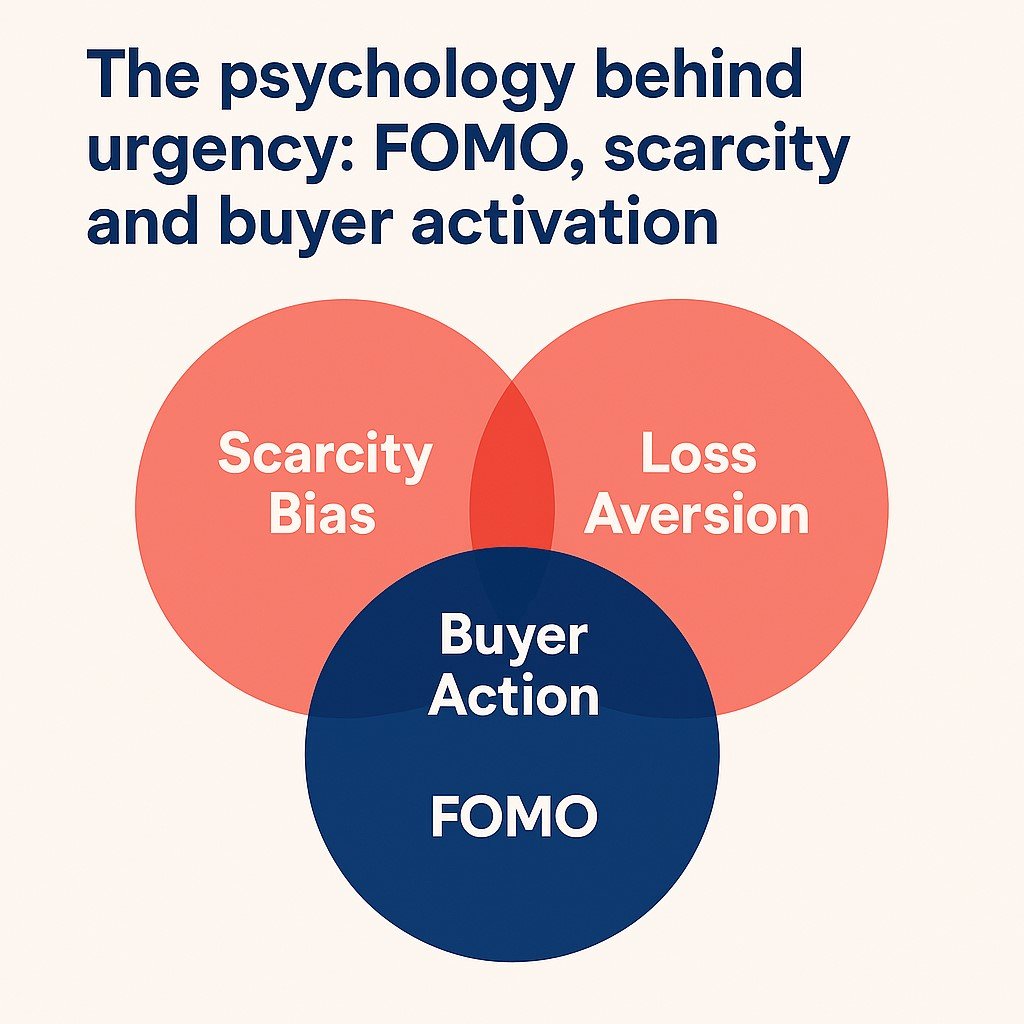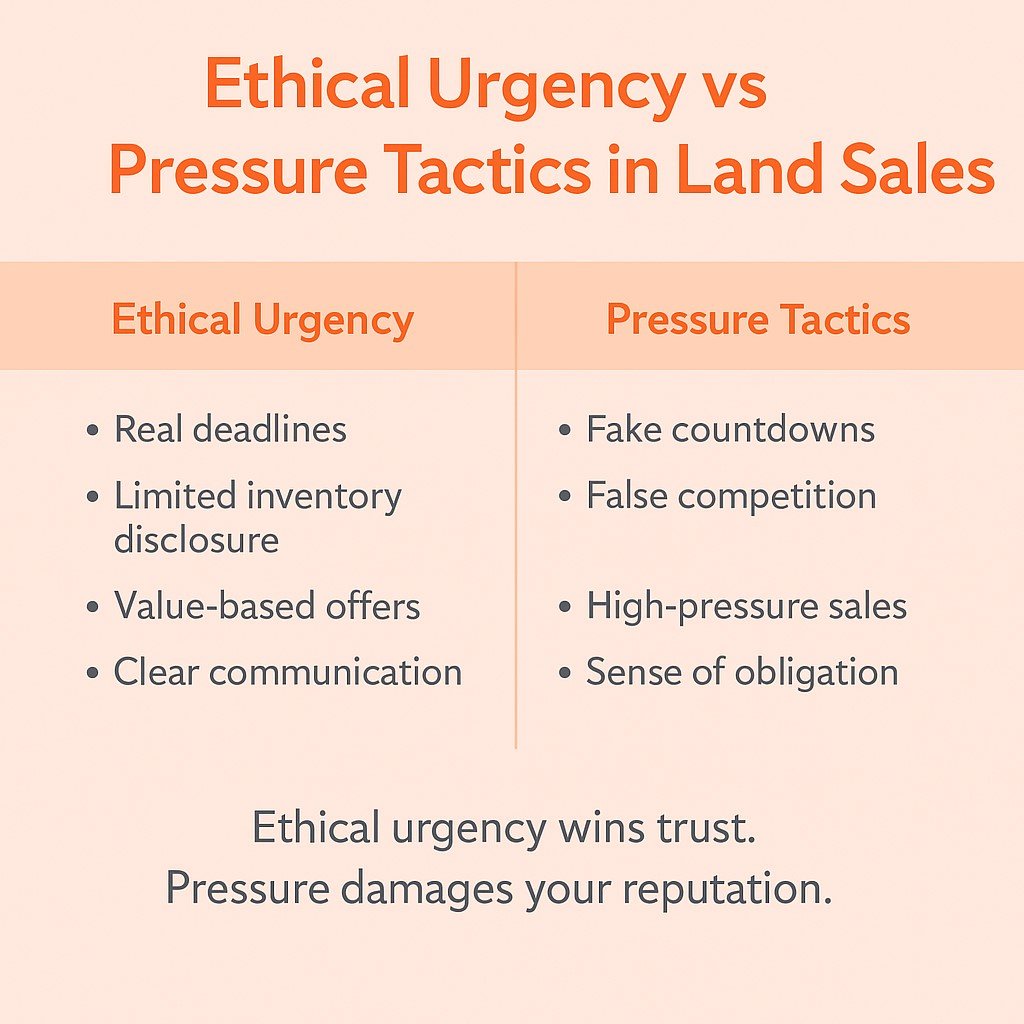Selling land requires more than just listing it online. It’s about moving potential buyers from interest to action. One of the most powerful ways to do that is through urgency and scarcity. When used properly, these psychological triggers can nudge hesitant buyers to make a decision faster, without pressure or manipulation.
In this guide, we’ll explore why urgency works, how to use it ethically, and what tools and copywriting strategies actually increase land sales. Whether you’re marketing infill lots, rural acreage, or investment parcels, you’ll walk away with proven ideas that drive faster buyer responses.
What psychological principles make urgency effective in land sales?
Urgency works in land sales because it taps into scarcity bias and loss aversion, causing buyers to act before missing out. These psychological principles trigger faster decisions by making the buyer feel the opportunity won’t last long.
When you advertise a piece of land as “only two lots left” or “price expires in 48 hours,” you’re not just sharing facts, you’re engaging emotional mechanisms that speed up decision-making. The scarcity bias tells buyers that something rare is more valuable. Combine that with loss aversion (the idea that people fear losing more than they enjoy gaining), and you’ve created a strong incentive for them to act now rather than wait.
For land investors, this is especially powerful. Many deals involve off-market properties, time-sensitive seller discounts, or flash incentives that can disappear. By reinforcing these details clearly and honestly, you motivate action without needing to apply pressure.
How FOMO shapes land investment behavior
The fear of missing out (FOMO) is a direct result of scarcity and social competition. If buyers believe others are interested in the same parcel or that the offer has a short window, they’re more likely to buy without dragging their feet. FOMO works particularly well in infill lots and county tax sales.
Scarcity vs abundance: Which motivates faster decisions?
Abundance may reduce pressure, but it rarely drives urgency. Scarcity triggers the feeling that a buyer must “claim it before someone else does.” When you highlight limited inventory or time-bound offers, you create a sense of exclusivity that helps convert indecisive leads.

“The psychology behind urgency: FOMO, scarcity, and buyer activation.”
How can I ethically create urgency without pressuring land buyers?
To create urgency ethically, use transparent deadlines, real availability, and value-based offers that naturally motivate buyers. This ensures your marketing builds trust while still encouraging timely decisions.
Ethical urgency relies on honesty and clarity. For example, if a discounted land deal ends on Friday, ensure that the timeline is real and enforced. If you only have five lots left, state that clearly without exaggeration. Buyers are susceptible to pressure tactics, and overuse of artificial urgency can damage your reputation and long-term results. The goal is to highlight the true benefits of acting now rather than misleading the buyer.
Many successful land investors use ethical urgency by combining clear expiration dates, limited quantities, and logical reasons for deadlines. For instance, “This price is only valid before the next tax roll” is both accurate and persuasive. Similarly, explaining that a seller needs a quick sale and will only hold the deal until Friday sets fair expectations without manipulation.
Examples of ethical urgency in real land deals
- “We’ve had three calls this week about this property. If you’re interested, I recommend acting by Friday.”
- “This pricing is part of our summer campaign and ends on August 1.”
- “Only two parcels left in this cul-de-sac zone. Others sold out last month.”
What not to do: pressure tactics that backfire
- “If you don’t buy now, someone else will take it today” (if it’s not true)
- Fake countdown timers or fabricated competition
- Saying “last lot” when several more are listed elsewhere

Ethical urgency wins trust. Pressure damages your reputation.
What are the best tools and copy tactics for urgency in land ads?
The best urgency tools include countdown timers, flash-sale CTAs, and limited-time pricing, combined with benefit-rich copy and real deadlines that prompt immediate action. These tactics work best when they’re specific, believable, and easy to act on.
Effective urgency doesn’t rely on vague terms like “soon” or “ending shortly.” Instead, it thrives on specifics: “Only two lots left,” “Offer ends Friday at midnight,” or “First 5 buyers get title transfer covered.” These phrases do more than just inform; they activate your buyer’s decision reflex. When paired with a real benefit (like savings, bonuses, or limited access), urgency becomes a tool of motivation instead of manipulation.
To execute these tactics at scale, use automation tools that help you embed countdowns in emails or sales pages, send timed SMS reminders, or create expiring offers inside your CRM. You can also track clicks or email opens to trigger urgency messages based on user behavior.
Copywriting urgency phrases that work
- “Only 2 lots left — reserve yours today.”
- “Sale ends Friday — lock in your price.”
- “Offer valid until August 1 at 5 PM”
- “Last chance to grab this 20-acre parcel”
Tools to automate urgency in your sales funnels
- Deadline Funnel — dynamic countdown timers for emails and landing pages
- Thrive Ultimatum (WordPress plugin) — evergreen countdowns for urgency campaigns
- ActiveCampaign — trigger-based urgency emails and SMS
- Land CRM tools — for lead segmentation and urgency tagging

Visual example of urgency copy and countdown for a land flash sale
How can I use urgency across multiple touchpoints without being repetitive?
You can apply urgency across SMS, email, and ads by varying the message tone, format, and trigger while keeping your deadline consistent. This creates a unified message without overwhelming or annoying your audience.
Repetition isn’t always bad, but sounding identical in every channel is. Instead, rotate how you present the urgency. For example, your email might use a formal subject line like “Offer Ends Friday,” while your SMS says “Clock’s ticking! Just 2 lots left.” The goal is to keep urgency fresh but anchored to a single truth: the timeline or quantity is real and limited.
Using urgency across multiple touchpoints also improves response rates because different buyers respond to different mediums. Someone may ignore an email but reply to a text. Others may only act after seeing a Facebook retargeting ad. Consistency across channels helps reinforce the urgency, while variation in copy style keeps it interesting.
Urgency in SMS follow-ups vs email campaigns
- SMS: Short, urgent language works best (“Last chance — ends at midnight!”)
- Email: Use countdown graphics, clear CTAs, and specific benefits with the deadline
- Email subject line ideas:
- “Only 1 Lot Left — Sale Ends Soon”
- “48 Hours Left to Secure Your Discounted Land Parcel”
Timing urgency messages throughout the buyer journey
- First touch: “Early access — claim your lot before public release”
- Mid-funnel: “This offer ends in 2 days — check it out before it’s gone”
- Final stage: “Final reminder — land flash sale ends tonight”
How do I know if my urgency strategy is working?
You’ll know your urgency strategy is effective if you see faster decision-making, more follow-ups, and shorter lead conversion timelines. These are clear indicators that urgency is triggering buyer action as intended.
Start by tracking how long leads take to respond after urgency is introduced. A reduction in this time from days to hours, for example, means urgency is motivating them. Monitor your click-through rates on emails with countdowns, the response time to SMS reminders, and the performance of limited-time landing pages. If urgency is done right, you’ll see faster opt-ins, more callbacks, and fewer leads going cold.
Another way to evaluate effectiveness is through split testing. Send one version of your ad or email with urgency language and another without it. Compare open rates, replies, and conversions. A well-timed “Only 2 lots left” message should outperform a generic “Available now” offer.
Key urgency metrics to track
- Lead response time (from contact to reply)
- Landing page conversion rates with countdowns
- Email open and click-through rates on urgent messages
- Close rate within urgency period
A/B testing urgency phrases and CTAs
- Test different calls to action: “Book Now” vs “Claim This Lot”
- Compare countdown timers vs static expiry dates
- Rotate urgency formats: text-based vs visual timers
Mini FAQ
Can urgency tactics backfire in land marketing?
Yes, urgency tactics can backfire if they’re fake, exaggerated, or reused too often. Buyers may feel manipulated and lose trust, especially if the offer doesn’t actually expire or limited availability was untrue. Always use real timelines and clear communication.
What if my land offer really doesn’t have a time limit?
If your offer has no deadline, focus on value instead of urgency. Use exclusivity, benefits, or education to guide decision-making. You can still build action through phrases like “Early access” or “Limited investor slots,” even without hard expiration.
How do I balance urgency with transparency in my emails?
Balance urgency with transparency by explaining why a deadline exists. Say things like “This price is valid until Friday due to a seller discount” or “We’re only releasing five parcels this month.” Buyers appreciate honesty more than pressure.



